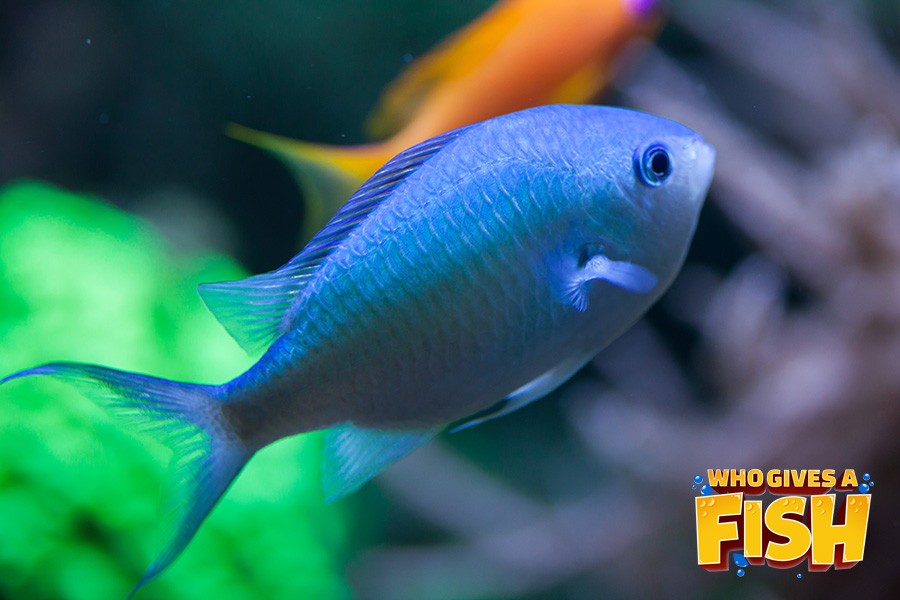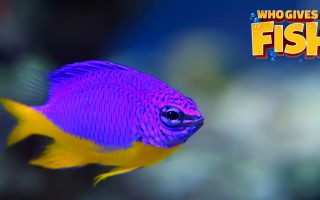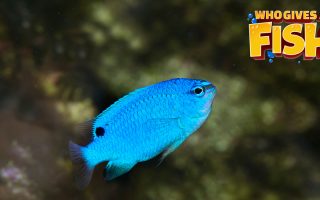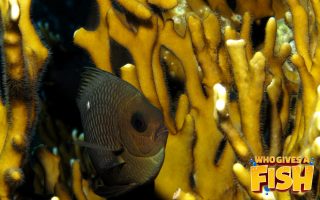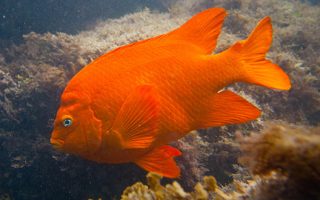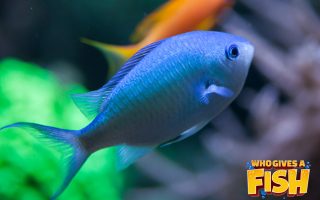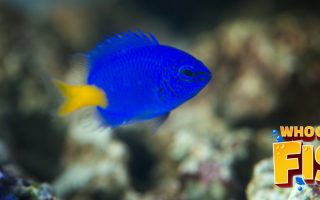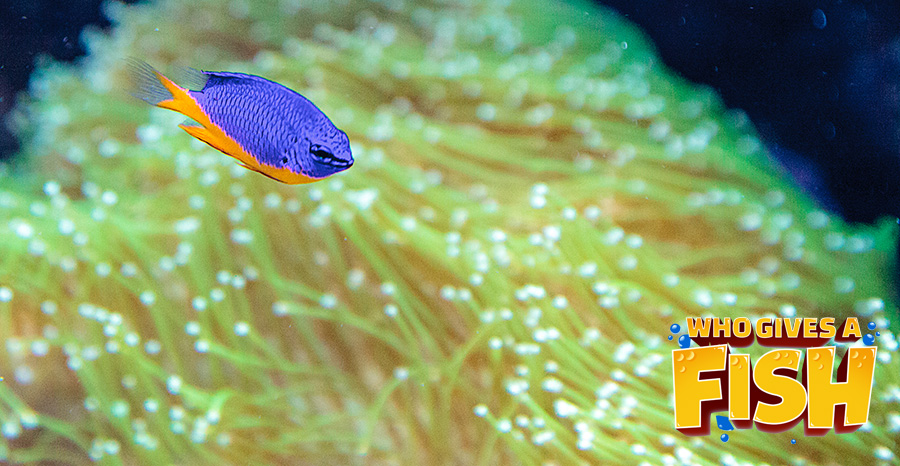Damselfish
With most Damselfish found to have bright colors and never growing above 3.9 inches (19 cm), they make for great additions to smaller reefs. They are hardy little fish that are easy to feed, generally very cohesive with other tank mates and are always easy on the bank balance when purchasing. These attributes see the Damselfish as being one of the most popular for marine aquariums.
Due to their hardy genetics, they are often chosen as the first additions to a new tank to encourage the nitrification cycle along its path. A general rule of thumb for this, is having 1 fish per 10 gallons of water.
It is important to note that the Pomacentridae family is a large group of fish of which the Damselfish is apart of it. Some of the species do not hold all these amazing attributes like the others do. As many Damselfish exhibit beautiful colors they quickly catch the eye of eager reef builders.
Unfortunately, these colors may only be present during the juvenile stages of life, fading away to dull colors once mature which can be to the disappointment of the purchaser- so it’s always important to research before purchase to fully understand the entire lifecycle of your chosen species.
The majority of them do stay around the 2-3 inch size, however such variations as the Garibaldi have been known to reach up to 15 inches (38cm) long.
The Damselfish remains one of the most popular selections for its good reputation. However, it is important to not that some species have different behavioral and social qualities. Some are known for being quite aggressive and even completely dominating an entire tank- making life for other tank mates unbearable, eventually leasing to deaths and the onset of illness from stress.
Many of the species found within the Pomacentridae family are known for their aggressive nature. Strong territorial behavior leads to aggression even when faced against other Damsels. It is best to keep these species as a single fish or in a tank that is larger than 50 gallons with plenty of escape routines and hiding places for other fish. Ensuring their other tank mates are bigger and also hold aggressive traits can be the best way to keep these little pocket rockets in their place.
On a brighter note, there are many species that belong to the sub family Chrominae found in the genus Chromis that are known to be very docile. The Chromis are another good example of easy, first additions to a reef. Like their Damsel cousins, they have a hardy reputation, easy to feed and a very rarely aggressive Damsel that are great to keep in groups within a tank.
The majority of Damselfish are marine fish, with a few species being found to reside in brackish lagoons and fresh water swamps. Most are located in tropical environments and moderate waters of the Pacific and Indian Oceans. Some species can be found in the Caribbean Sea and Atlantic Ocean.
Damsels are generally abundant in most shallow reef environments that are 6 ½ to 49 feet (2-15 m) deep, with a few exceptions to other habitats. Generally found in sandy sheltered lagoons they can be located in tidal creeks and even steep drop-offs and reef slopes. Some have been found to live in deep water environments that go below 328 feet (100m). They can be found in an array of locations under the surface, from rocky areas to sea-grass beds and many forming schools in the water column.
It has been thought that the Damselfish could be closely related to freshwater Cichlids with many of them being similar in appearance and behavior. As in Cichlids, they also have one nostril on either side of their heads with their mouth located at the end. They are seen with a long continuous dorsal fin, a laterally compressed structure with large scales that extend onto their fins.
There is a notable difference between species as some are found to be radiant in color while others only sporting dull colors. Some remain similar colors from juvenile to adulthood. While others will go through remarkable changes during maturity.
With the majority never growing above 3.9 inches (19 cm), there are some exceptions that will extend past this length. The smallest will be the Lined Chromis, Chromis lineata, found in the Indo-Pacific regions, coming in at a small 2.75 inches (7cm).
The largest is the Garibaldi Damselfish, Hypsypops rubicundus, which can reach up to 15inches (38 cm), found in the subtropical part of the Eastern Pacific Ocean. They have a lifespan of around 6-8 years with many living up to 10-12. Some have been known to last 18-20 years in a captive environment.
Species
These fish are found to be members of the Pomacentridae family of Damselfish and Anemonefish. There are around 360 species in about 29 genera. This is then split up into 4 subfamilies known as Pomacentrinae, Lepidozyginae, Chrominae and Amphiprioninae. The well-known Clownfish, also known as the Anemonefish, are found within the subfamily Amphiprioninae that has 30 known species.
With the exception of the Clownfish, all the fish in the Pomacentridae family will be referred to as Damsels or Damselfish with the majority of Damselfish belonging to the the Subfamily Pomacentrinae that holds over 200 currently recognized species. Close behind this with over 100 known is the Chrominae subfamily. The Fusilier Damselfish (Lepidozygus anthioides) is the only single recognized species found within the Subfamily of Lepidozyginae.
Behavior
These fish are usually very rugged and will thrive in a few saltwater aquariums. A tank of at least 20-gallons in water volume is recommended for the small to medium breeds, the bigger species will thrive with a minimum of 30 gallons. Be sure to include décor and rock structures for hiding along with a lot of open areas for swimming.
Clownfish in an aquarium have no specific lighting needs, but if housed in a reef habitat, many of the other inhabitants will require an extremely bright light. You can supply a host anemone, but you must possess a healthy system in order to keep up with the nutritional needs of this animal.
Reef aquariums need plenty of live sand and live rock. Helpful bacteria will occupy the rock and sand in order to help keep the water pure. This sort of tank requires the addition of some specific equipment to supply ideal water motion and bright lighting. Reef tanks also need good filtration and a protein skimmer is helpful also. Frequent water changes are crucial, as they replace critical trace elements that the corals and fish deplete, such as iodine, calcium, strontium and magnesium.
Feeding
Damselfish are found to be omnivorous with the majority of the diet being herbivorous. Many species will be seen feeding on areas of filamentous algae, small inverts and sometimes zooplankton found in the water column.
They have a good reputation for being easily fed within an aquarium, taking to most dried and frozen foods and benefitting a lot from the presence of alae to graze on. A good well-balanced diet is essential to maintaining healthy Damselfish within the aquarium. If possible, a range of food should be provided for them in the following forms. Flake food, pellets, blood worms, mysis shrimps, finely chopped fresh sea foods and if possible at presence of a copepod population for added variety.


